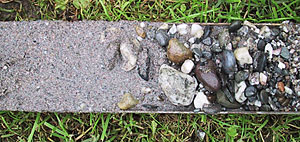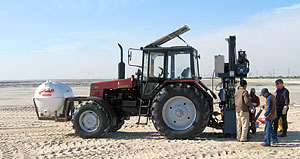Sonic Drills
 Represented in Australia and New Zealand by EVH Drill Engineering
Represented in Australia and New Zealand by EVH Drill Engineering
What is Sonic Drilling and how does it work?
Technically, for the boffins, “Sonic drilling is a soil penetration technique that applies the principals of Bingham’s findings on the fluidisation of porous materials in combination with the laws of inertia.”
Simply put, the drill string stretches and shortens extremely quickly, making the material around and in front of the rods lose most of the friction, allowing the drill string to fall into the hole. Not unlike a hot knife through butter (which uses thermal energy or heat, to liquefy the butter).
Although the head is mechanically complex, the operating principle is simple. Depending on the size of the sonic head, an even number of counter rotating, synchronised eccenters (or off set weights) driven by high speed hydraulic motors provide the drilling power. With these motors running at several thousand Rpm, a vibration frequency of around 150 Hz is generated in the drill string (and casing). These sonic (because 150 Hz is within the audible range) energy waves are transmitted though the drill string to the end string and then reflected back. This causes the drill string to stretch (and thin) and shorten (and thicken) some 150 times a second. This intense vibration causes a very thin layer of soil particles directly surrounding the drill string to lose its structure. Instead of the stiff mass that requires torque and weight to penetrate, the soil behaves like a fluid powder (in an unsaturated zone) or as a slurry or paste in a saturated zone. Fluidisation or liquefaction dramatically reduces the friction between the drill string and the surrounding formation. In effect, allowing the drill string to fall into the ground. This means rapid penetration of the drill rods with very little weight or rotation. The stationary soil, compared to the high-speed moving drill rod and sample barrel, prevents the formation from sticking to the wall of the drill rods or the sample barrel, inside or out. This liquefaction and inertia effect enables collection of long samples in both good ground and in traditionally hard to sample formations.

The operator is able to vary the frequency and drill bit weight to match the material he is going through, ensuring the best penetration rate and most accurate sampling is obtained.
Because there is no need to overcome the friction between the hole wall and the drill pipe, on smaller machines, drilling in alluvial type formations, rotation is only required for rod coupling the drill string.
Apart from Environmental, Geotechnical and Mineral, the range of tooling options available, enable the drilling system to be used not only for sampling but also those occasions where a only the hole is required, that is for setting piezometers, seismic shot holes and the emerging Geothermal drilling etc.
Having a small footprint and lack of need to introduce fluid into the hole, this is an ideal drilling method when contamination is potentially a problem.
Like most drilling methods, Sonic Systems come in a range of sizes designed to suit particular applications. Larger machines are designed to drill harder formations; these machines vibrate, rotate and inject a fluid for cooling and removal of waste cuttings.

Links to Sonic Drilling Products
 |
 |
 |
 |
 |
